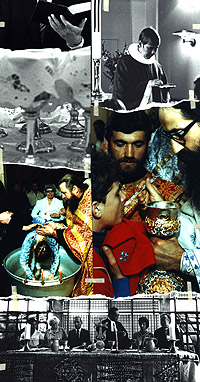
Moving clockwise from top left, the images are 1: Moscow, Russia, 1989: Moscow Baptist Church; 2: Denmark, 1985: St. Paulís Church at Hadsten; 3: Albania, 1993: The Church of the Annunciation in Tirana; 4: Geneva, Switzerland, 1984: Eucharist at the Ecumenical Centre; 5: Russia, 1994: Baptism at Akademgorok/Novosibirsk, the Church of All Saints (Photos: Peter Williams/WCC).
Our
Churches have made significant progress in moving towards recognition of each other's baptism. But different understandings about the ministry of the church -- especially around the office of bishop and the ordination of women -- remain an obstacle to churchesí recognizing each other. And the fact that all churches cannot join together in a single celebration of holy communion continues to be one of the most painful manifestations of their division.
At stake in these questions are not just technical issues to be debated by scholars and professional theologians within the church. The WCC's Vancouver assembly in 1983 saw the "eucharistic vision" as central not only to the unity of the church but also to the renewal of humankind:
eucharistic
vision
Meeting in Lima, Peru, in 1982, the World Council of Churches' Faith and Order commission agreed to send an ecumenical text pointing to broad areas of convergence on these three subjects to the churches for official responses. The Lima text on Baptism, Eucharist and Ministry was widely acknowledged as a major ecumenical step forward.
Christ -- the life of the world -- unites heaven and earth, God and world, spiritual and secular. His body and blood, given us in the elements of bread and wine, integrate liturgy and diaconate, proclamation and acts of healing. Our eucharistic vision thus encompasses the whole reality of Christian worship, life and witness, and tends -- when truly discovered -- to shed new light on Christian unity in its full richness of diversity.